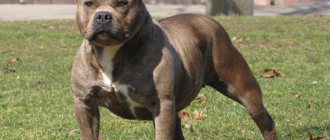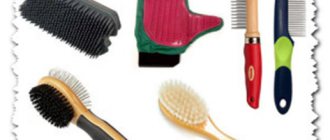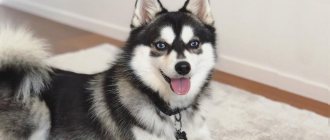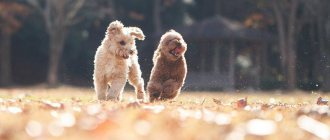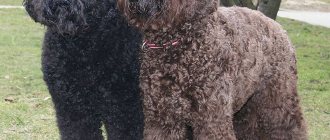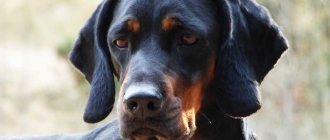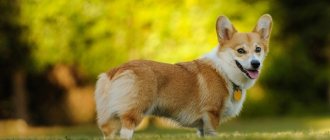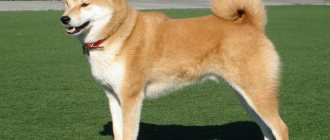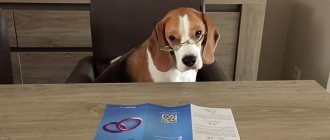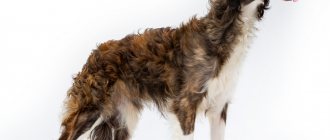What breed of dog is associated with Japan? Among them, it is worth highlighting Shikoku. In Europe, these dogs are not very popular, however, it is worth getting to know the representatives of this breed, because these are magnificent Japanese primary dogs that have a considerable circle of fans on the Asian continent. Shikoku, one of the six Japanese Spitz breeds. This is not a dog for everyone.
Origin of the Shikoku breed
Shikoku dogs were known to the inhabitants of Japan already in ancient times, and were closely associated with hunting. The game had no chance if any of the hunters took this breed with them. Shikoku, even in its homeland, is a rare species - the local population is only 1000 dogs. Outside of Japan, this breed is completely unique, since a pet recognized as a national treasure is difficult to take abroad. The honor of acquiring a Shikoku can only be given to those individuals who show serious interest in the breed.
The full name of this breed is Skikoku Inu, which can be translated literally as Shikoku, a breed of dog and is associated with the place where it comes from. During the times that grant dogs breed status, three main varieties are distinguished, which are characterized by origin from different regions of Japan.
The first lines consisted of dogs: Awa, Hata, Hongawa and Uwajima, but the differences were almost imperceptible, so this division was greatly simplified over time. Individuals of some lineages went extinct completely, while others merged their patterns. Today's Shikoku is a mixture of the characteristics of the Hate and Hongawa line, although the FCI template separates the two varieties.
What does Shikoku look like?
This is not a large dog, but the size can be defined as medium. Despite the fact that he is small in stature, he is strong, fast and independent. The height at the withers reaches 55 cm if we are talking about males and 50 cm for females. It is characterized by a strong and compact body structure, equipped with thin muscles.
What attracts attention in the appearance of a Japanese dog. Of course, these are upturned, pointed ears, as well as deep-set eyes. Dogs have a mantle consisting of two layers: a soft undercoat and a straight, coarse coat.
The most popular shades: black with shades of sesame, ore, sesame or sesame. The eyes are usually dark – often dark brown. The Hongawa variety has a finer structure from Hate, finer hair and more slanted eyes and other color combinations on the body, but the differences are rarely noticeable at first glance. Height : males 52 cm, females 46 cm (tolerance +/- 3 cm)
Weight : dogs average 19-26 kg, females 16-19 kg
Coat: short, two-layer: the hair is quite hard, the undercoat is soft and thick; on the tail the hair forms a brush.
Shikoku dog - character We already know what a Shikoku dog looks like, but what is the character of these animals? Shikoku are dogs full of energy and curiosity about the world. Their behavior shows great joy in life. Very smart and intelligent, they love to learn new things. It is these two characteristics that distinguish it from its larger and smaller brothers. The dog has a big temperament and a big heart!
The primitive hunting instinct lies dormant in him, thanks to which he often shows cunning and intelligence, but before buying it is also worth getting to know the other side of the breed. Shikoku dogs are independent and have strong personalities and require a firm hand and implementation of puppy training to raise.
Despite the initial stubbornness, the Japanese dog enjoys learning new things. He is extremely friendly towards family members and devotes his time entirely to people close to him. The situation may change in the company of other dogs, whose presence Shikoku does not always accept. Despite the fact that he is small in stature, he is strong, fast and independent.
source
Skills
In relation to members of the domestic flock, Shikoku is incredibly sociable and responsive. A well-bred representative of this breed is ideal as a companion dog. When it comes to relationships with other animals, we cannot forget that the Shikoku is a hunting breed, endowed with a strong hunting instinct. Of course, as a puppy, the dog is used to, for example, a cat, and can live happily with it, but it will also chase cats in the backyard. It is better not to leave small animals alone with him...
You should also be careful when meeting other dogs, as shikoku can be dominant towards animals of the same sex.
Training and education
However, we must not forget that the Shikoku dog is the original one. Typical of the Spitz, the main feature is its independence. You cannot expect blind obedience from him. We need to outsmart him and make him want to do what we want for ourselves. This is where teaching methods come in handy. It is necessary to clearly define the rules of the game and convince the Shikoku that cooperation with a person is attractive, then teaching him becomes a complete pleasure.
Who is this breed for?
Shikoku is not for people just starting their dog-raising adventure. This breed requires experience, perseverance, patience and gentleness from the owner. Shikoku is not a good companion for sedentary people or those who spend most of the day outside the home. The owner of a Shikoku should be a person who likes to spend time actively and is able to provide the dog with a sufficient amount of it.
The Shikoku requires an owner who already has some experience in raising dogs and can gain authority from him, and on the other hand, respects the independence of the primary breed.
Pros and cons of the Shikoku breed Disadvantages
- independent and stubborn
- strong hunting instinct
- can be aggressive towards other dogs
Advantages
- smart and quick-witted
- attached to family
- less stubborn and independent than other native Japanese breeds
- easy to care for
Interesting facts about the Shikoku breed
Shikoku is also known as kochi-ken (“ken” means dog in Japanese, just like “inu”).
Health
Shikoku is characterized by iron health. This is a strong and stable dog. The thick, double-layered coat provides excellent protection from the cold. Fortunately, Shikoku are not burdened with serious genetic diseases. In summer you should protect it from being in the sun for too long. High temperatures are very dangerous for our four-legged friends. You can easily overheat your pet and endanger their life and have a stroke. In summer, Shikoku should have constant access to fresh drinking water and a shaded place where it can rest. On hot days, it is better to go for walks in the early morning or late afternoon, when the air temperature is not too high.
Nutrition
Shikoku are not particularly picky when it comes to feeding. You can give him ready-made food or food you prepare yourself at home.
Care
Caring for the breed does not cause problems. Regular brushing, more intensive during the shedding period, and bathing if necessary is sufficient.
Shikoku dogs – price
Shikoku are not cheap breeds and you should expect to spend a lot of money to buy a puppy. The average price for Shikoku is 2.5 thousand euros. An additional obstacle is the presence of representatives of this breed and breeding in Poland.
Shikoku is most popular in her own country, but her fans can be found all over the world. The new owner of this breed must, first of all, be aware of the requirements that it places on its guardian. This is an active dog, so you need to be able to keep him active and spend time with him. Having a pet is a big responsibility, which begins much earlier than the arrival of a new family member in the house. A future dog owner must first answer key questions. Does he know the specifics of the breed and meet its requirements?
Shikoku can live in the city, although an excellent place to live would be a country house and a securely fenced garden where the dog can run freely. If you are convinced that the requirements of this unusual dog will be met, then you can become a friend with whom you can create a close-knit team for many, many years!
Interesting for you:
Breed characteristics
Shikoku is a medium-sized dog, weighs up to 26 kg and is 50-55 cm tall at the withers. Representatives of this breed live for about 12 years. The breed is recognized by the FCI - animals are classified as Spitz and primitive type breeds.
The animal is perfect for hunting, but can also become a companion for a family or a single person. The pet is very devoted to one owner. Left without an owner, he may not recognize another.
The pet will get along well with people and other animals, even cats. But he is unlikely to be able to have normal contact with other dogs. This is a characteristic feature of the Shikoku breed.
Training
Due to the difficult nature of the Shikoku, it is better for experienced dog breeders who also have the opportunity to keep a dog outside the city to get such a dog. As already mentioned, long walks are important for these dogs; they need to run at least 6 kilometers a day to maintain physical and mental fitness.
When raising these dogs, it is important to prevent them from becoming dominant in the home. The first thing a Shikoku must learn is to respect its owner.
It is better not to use physical violence. Since Shikoku have a high level of intelligence, training should be based on the animal’s interest in following commands. It is better to carry out the training process in the form of a game, so the dog will be better able to grasp new commands and carry them out with more pleasure than under duress.
Socialization is a very important aspect of training. It is important that the dog communicates with people and is not afraid of them; this will help avoid unnecessary aggression and raise a confident animal. If the dog is planned to be used as a hunting dog, then the puppy should be taken out into the forest from an early age.
Shikoku are recognized by the FCI federation and participate in exhibitions
History of the breed
It is believed that the Japanese wolf became the ancestor of the Shikoku. The breed appeared in the Middle Ages on the island of the same name - Shikoku. It is also believed that the animals were bred in Kochi Prefecture on the island of Shikoku, for which the breed is also called Kochi Inu.
For a long time, dogs were used by Matagi hunters. They took the animal to hunt for large prey (for example, wild boar). The problem began during the economic crisis in the country, when we had to give up keeping pets.
There were few dogs, and the authorities decided to recognize the breed as a natural monument of the country. This happened in 1937. However, after World War II, the breed still had to be revived. Today, approximately 7,000 Shikoku individuals are registered in Japan.
Choosing a Shikoku puppy and price
There are very few dogs of the Shikoku breed in the world, there are few of them even in their homeland in Japan. The popularity of the breed is not growing yet. Perhaps this is due to the presence in countries of their own so-called natural breeds (huskies, Samoyeds). But there are still lovers and connoisseurs of the breed.
There are Shikoku nurseries in Europe, one of them is based in Estonia, and there is also a nursery in the Netherlands. If you wish, you can find a purebred Shikoku puppy in Russia. In Russia these are nurseries:
- "Demishstar" in Vladivostok (headed by Zhanna Demisheva);
- FUDZISAN in Saratov (founder Julia Tarkhanova).
If you want to buy a Shikoku puppy, you should contact one of the breed clubs. It is impossible to choose a purebred puppy yourself if you are an amateur dog breeder. Alternatively, you can buy a puppy in Japan. True, in this case you need to be prepared for a lot of effort and money.
The cost of a baby Shikoku on the market in Japan is 250 thousand yen, which is approximately 8 thousand dollars.
The first Shikoku puppies in the FUDZISAN kennel were born in 2018
Description of the breed (appearance)
The dog stands out for its good proportions, strong bones and well-developed muscles. The head is distinguished by a wide forehead and a strong skull. The transition from the forehead to the muzzle is weakly expressed. The eyes are dark brown.
The coat is double, the color can be different: black, brown, red, sesame. The limbs are powerful, especially the hind limbs. You can notice developed muscles. The paws are quite large, the claws are black.
The dog's coat is straight and very hard, but the undercoat is thick and soft. Particular attention should be paid to body coloring - the location of spots and the distribution of colors. The breed is characterized by the urajiro type of coloring. This makes all representatives of the breed stand out.
Breed diseases
The Japanese Chin cannot be classified as a dog with a weak immune system and frequent illnesses. But there are a number of hereditary diseases and predispositions that are inherent in the dog. The expressive appearance of the dog is associated primarily with genetic mutations. A flat muzzle and shortened skull bones can trigger the development of brachycephalic syndrome, in which the structure of the upper respiratory tract changes, which then causes breathing problems.
Japanese Chin puppies often have hydroceles on the brain in their first days. There is a rare hereditary disease called GM2 gangliosidosis, which disrupts the functioning of the central nervous system. Sometimes a chin is born with distichiasis, in which the dog grows a lot of eyelashes that irritate the mucous membrane of the eye, which provokes the appearance of tears, strabismus, and the development of purulent diseases. There are deviations in the time of loss of baby teeth, which then affects the pet’s digestive system.
Chin is characterized by malfunctions in the musculoskeletal system and poor development of the reproductive system.
Once a dog reaches the age of ten, it may begin to experience hearing problems.
Character of the breed
Shikoku is an ideal choice for an experienced owner. The dog requires control and training is required. The animal can be disobedient, especially if it picks up a scent. A well-mannered pet is balanced and calm.
The attitude towards strangers is calm and even indifferent, but it is difficult to win the dog’s trust. It will take a lot of time. The dog will have good contact with family and play with other pets. Relationships with dogs of your own or other breeds can be strained.
An animal requires respect, so children should be taught how to properly treat a dog. In general, the dog has a positive attitude towards children and can even outplay them - Shikoku are very energetic and tireless in games.
Links[edit]
- ^ ab FCI breed standard
- FCI breed standard
- JKC breed standard
- Haruo Isogai was a dog breeder who developed a system of classifying Japanese dogs based on appearance as a nationalistic response to the adoption of European breeds by dog enthusiasts in Japan in the 1930s. ([1] in Dutch) ("archived copy". Archived from the original on 2009-04-06. Retrieved 2008-04-12.CS1 maint: archived copy as title (link) in German) There is no evidence that that he had any relevant scientific training or even that he ever called himself a "dog handler".
- https://shikokuclub.com/history/
Content Rules
The dog can live in an apartment or in a private house. She will be especially happy in an enclosure. It is important to remember that Shikoku requires intense physical activity. Without training, the pet will be bored and lose its former passion.
You need to take the dog for a long walk and play every day. You can play sports with your dog - it’s very interesting. It is recommended to go hunting regularly - the Shikoku will be delighted with such outings.
Shikoku cannot sit in the house all the time; he is simply not designed for such a pastime. This is a suitable pet for a person who prefers an active lifestyle, as well as for a hunter.
Interesting Facts
Here are some interesting facts about the Shikoku breed that you may find interesting:
- In addition to the usual name Shikoku, the breed is called Shikoku, Shikoku Inu, Shikoku Inu, Shikoku Ken.
- There used to be breeds that were spotted, tan and tri-colored.
- Despite the fact that Japan is considered the birthplace of dogs, it is very rare to meet pets of this breed in the country.
- The breed is a national treasure and is protected by the state itself.
Despite the fact that the Shikoku breed does not differ in appearance and character from many hunting breeds, its cost is high. The best way to keep a pet is in a country house with a large local area where the dog can take long walks. The breed is suitable for connoisseurs of Japanese culture. Due to the high price and urban lifestyle, Shikoku is not accessible to many Russians.
Rules of care
Particular attention should be paid to the dog's claws; they grow quite quickly. The claws will need to be trimmed and cleaned. It is also worth paying attention to the hygiene of your mouth, eyes and ears. As for wool, it will not cause problems.
Your pet's fur should be brushed once a week. It is thick, but cleans itself, so you should not bathe the animal too often. If the owner bathes the dog three times a year, this will be enough.
For combing, it is worth purchasing combs that have different lengths and frequencies of teeth. These brushes are suitable for thorough grooming. In rare cases, brushing twice a week may be necessary.
Kishu, or Kishu
Kishu is an aboriginal hunting dog that appeared on its own without human intervention, on the hills of Kishu Island, where its name comes from. Its color is usually white, monochromatic, although red, brindle or sesame are also found. The character is calm. Kishu is silent and does not bark over trifles, although she is vigilant and distrustful of strangers. Due to all these qualities, it is perfect as a watchman and security guard.
Kishu can be kept in the city if you remember that the dog needs activity and physical exercise, for example, participating in bicycle rides with the owner. If the right conditions are created for her, she will faithfully serve her owner for many years.
Feeding rules
Shikoku is fed twice a day. This is enough for an adult dog. Puppies can be given food three times a day, but no more. For your pet, you need to choose special food that is intended for medium-sized purebred dogs.
Of course, you can create your own diet for your dog. But then you will have to calculate proteins, fats and carbohydrates, monitor the vitamins in the feed and microelements. This is quite difficult, especially if you have not done this before. It’s more convenient to choose good food and not worry about your pet’s diet.
Diet
In Japan, pets are fed both prepared food and natural food, creating a balanced menu. Some dogs don't like beef and chicken.
Attention! Since ancient times, Japanese dogs ate sea fish and seafood, seaweed and rice. These products predominated on the island. Their body is able to digest “light protein.”
An adult dog needs to be fed twice a day, 400-500 grams per meal. Various vegetables and fruits, sea fish and seafood, lean meat, grains and dairy products are suitable for feeding.
It is forbidden to give river fish, as it contains a lot of bones, various smoked meats and pickles, sweet and starchy foods, corn, and food with harmful additives.
When purchasing ready-made food, preference is given to products based on rice, tuna or salmon. Ready-made food is offered in two types: dry and wet.
Wet ones do not make dogs thirsty, have a jelly-like texture and contain fewer harmful substances.
When choosing ready-made food, it is better to give preference to one type, since when alternating, dogs may experience problems with the gastrointestinal tract. The disadvantages of ready-made food include the presence of preservatives and other harmful substances, but in expensive products special attention is paid to the composition.
Health
The Shikoku is a native breed that developed without human intervention and evolved without crossbreeding. Therefore, representatives of the breed do not suffer from any congenital or hereditary diseases.
If your dog is not properly cared for, some heart and gastrointestinal diseases may occur. Manifestations of dysplasia of the elbow and hip joints are also noted. If problems arise, it is recommended to contact a veterinarian as soon as possible. The specialist will prescribe treatment.
You can find a veterinarian through a special application Petstory.ru. You can find a link to the application here: https://petstory.ru/prilozhenie-konsultacija-veterinar/.
What to name a dog
The chosen nickname should personify the character of the animal and indicate the breed. The name should be easy to pronounce and remember for both the dog and the person.
Soft and gentle sounds indicate a beautiful domestic creature, while harsh and hard sounds indicate a shepherd or hunting breed. It is also recommended to choose nicknames with the letters “r”, “k” and “s”.
Nickname options for boys:
- Aki;
- Budo;
- Vasey;
- Goro;
- Oji;
- Haru;
- Yusi;
- Poti.
Nickname options for girls:
- Bansei;
- Kaden;
- Mamori;
- Oka;
- Pattiri;
- Singi;
- Tsuru;
- Enka.
These are Japanese nicknames, but you can also choose familiar Russian names, everyone decides for themselves.
It's easy in the app:
- consult a veterinarian remotely;
- choose a veterinary clinic;
- make an appointment with a specialist;
- find food, clothes for dogs, medicines in stores.
This is a convenient solution even for people who live with pets outside the city. They can always count on qualified assistance from highly qualified veterinarians. If necessary, they will also be able to make an appointment in advance with a veterinarian in one of the available cities.
Download a specialized application for pet owners Petstory (Petstory) on the IOS (ios) and Android (android) platforms via the link - https://petstory.ru/prilozhenie-konsultacija-veterinar/.
Economy
The Inland Sea coast, which covers the island from the north, is a fishing and industrial center and a busy communications channel. Eleven prefectures border the Inland Sea. Industrial activity and the reclamation of new land from the sea have disturbed the coastline, polluted the water and hampered fishing. Industries and sectors with a long tradition: traditional crafts, agriculture, livestock, food processing, agricultural products, fisheries, seafood, aquaculture, forestry, wood, pulp and paper, shipbuilding, textiles, metal products, transport equipment, non-ferrous metals, chemicals, oil refining.
New industries: electronics, LED products, nanotechnology, biotechnology. In the southern part, residents are engaged in growing citrus fruits, harvesting and fishing. The growing season here is up to 260 days.
Shikoku's overall gross domestic product (GDP) for major industries is 5.6% of the national total, which is higher than average compared to other regions of Japan. The value of goods produced is about 80 million US dollars, or 3.1% of the country's total.
Afro Samurai!
An African, presumably from Mozambique, arrived on the islands in 1579 as a servant of the Italian Jesuit Valignano
The unusual appearance attracted the attention of the unifier of Japan and lover of foreign wonders Oda Nobunaga, who tried to wash off the ink-covered gaijin. Huge by Japanese standards, as strong as ten men,” and the brave African entered the service of Nobunaga and became one of his bodyguards
He showed himself worthily on the battlefields and two years later received samurai dignity, an estate, and the name Yasuke - the real one was lost in the darkness of centuries. Yasuke defended the Honnouji Temple from the troops of the traitor Mitsuhide, but the forces were unequal, Oda Nobunaga died. The African broke through to the positions of the overlord's son, Oda Nobutada, but he was also defeated at Nijo Castle and forced to seppuk. Yasuke survived the fall of the Oda house: the victors sent him to the Jesuits.
Intelligence
Akita Inu is distinguished by its keen intelligence and observation. They are able to remember the habits, intonations, facial expressions of the owners, and try to follow the established routine. Breeders claim that these dogs contain eastern wisdom accumulated over thousands of years.
The “smiling” dog is not without cunning. She will try to distract her owner with all sorts of tricks if she does not want to complete the task given to her. You can cope with a quirky pet only by showing strength of character.
Attitude towards children
Adult Akita Inus are not very playful, but they are very responsible. Therefore, they are unlikely to be suitable as a companion for a teenager or preschooler. Proud Japanese women will not want to spend all day running around getting fetched. They will not tolerate rude treatment of themselves. An Akita Inu will not show aggression towards a child; it will simply hide from him.
But for children of primary school age, such a pet will become a real protector. The desire to fight to the death for their family, inherent in their genes, has made selfless dogs excellent “nannies”, under whose supervision you can safely leave a child.
Appearance of the Japanese Chin
Distinctive characteristics of the Chin are its miniature size and neat build. Small dogs have the highest value. Girls often have a more elongated torso.
Frame
The dog's back is straight and small, the lower back is wide, close to a circle in shape, the chest is widened, the ribs have a moderate bend, and the belly does not protrude.
Head
The skull is also quite wide and rounded, the forehead and muzzle are located quite close. The pads above the upper lip are quite pronounced. The nose is in line with the eyes, the nostrils are wide.
Teeth and jaws
The teeth are quite strong and white. You can often find cinchonas with incomplete teeth, for example, with missing lower incisors. This is accepted as a standard and is not a vice. The bite is mostly straight, but scissor bite and underbite also occur. This also does not apply to the defective development of quinine. The jaws are small and quite advanced.
Eyes
The Japanese Chin's eyes are set wide apart, round in shape and black in color. If the eyes are too large or too prominent, this is considered a deviation from the standard. If the Chin has purely Japanese roots, then its muzzle is characterized by a certain amazement.
Ears
The ears are triangular in shape and wide, hanging down when calm, but can rise slightly when alarmed. Long hair covers the ears. The ear is thin and light, and not heavy compared to a spaniel.
Neck
The neck of the Japanese Chin is short and set slightly high.
Limbs
The forelimbs have thin and smooth forearms. The area below the elbow is densely covered with hair, which smoothly falls down. The hind limbs have angles, but they are not so obvious. The back of the thighs is “dressed” in long hair. The paws are shaped like an oval, a little like a hare's. The fingers are pressed tightly against each other. It would be nice to have fluffy tassels between your fingers.
Movement
The Chin's gait is light and elegant. While walking, he behaves a little arrogantly, raising his paws high.
Tail
The tail resembles a steering wheel in appearance, lies close to the back, and is covered with long hair that falls apart when moving. The dog, like a peacock, straightens its little tail when it is happy to meet its owner or guests.
Wool
The coat of the Japanese Chin is characterized by its smoothness and silkiness. Outwardly, it resembles a long cloak that envelops the dog. There is, one might say, no undercoat at all. The hips, ears and tail have the most fur.
Color
The most common spotted dogs are black and white or white with red spots. Red color varies in intensity, from lemon to chocolate. It is not recommended to use chocolate-spotted quinine for offspring as it may affect the health or life of the puppy. The spots should not be concentrated in one place.
The presence of a white stripe that runs from the forehead to the bridge of the nose is considered attractive.
Japanese Chin
We should start the review with the most charming Japanese dog, which has long taken a place in the hearts of a large number of people. We are talking about the Japanese Chin. This little dog is so cute, active and playful that it simply has no equal among miniature pets. Only the Pekingese could compete with her, but his short legs and heavy landing simply do not allow him to catch up with the perky, self-confident and light little one.
The Japanese Chin is filled with a sense of self-importance and wants to be the center of everyone's attention, so it becomes very upset if its own attention is rejected. For more than 1000 years, chins belonged only to the imperial family, being royal favorites. One of the emperors even ordered them to be worshiped, declaring the dogs sacred. They had their own servants and doctors, and only members of the imperial family could own them. Especially miniature specimens were kept in cages, in a suspended state. A pair of Chins was given to Queen Victoria in 1853, which influenced the further development of the breed.
The Japanese Chin is unusually graceful, with a proud posture and luxurious coat. The coat color can be white with either black spots or red markings. The more distinct and brighter the red color, the better it is considered. The spots on the head and ears should be placed symmetrically relative to each other. Some believe that chins are descendants of a lion and a butterfly: they really look like a lion with their muzzles and are mobile, fluttering like butterflies.
Kai
Very often, breeders pass off this breed as an Akita, because the fine line between them can only be assessed by a professional. By the way, representatives of these breeds go together in the rings at small exhibitions. Kai is a northern hunting sled dog; he does not understand life without movement. These Japanese dogs are not at all aggressive; they are docile, kind and loyal to their owner. A reliable friend can stand up for himself and his owner.
If you like to spend your free time at home watching TV, then this is not the dog you need. Thick, stuffed wool allows you to spend any amount of time in nature. It is best if you live outside the city, so your pet will have more opportunities to fulfill his needs for movement. The kaya's coat is short, despite the dense undercoat, so it does not need to be brushed often. You shouldn't bathe your dog unnecessarily, otherwise you will wash away the oily lubricant that is necessary to protect him from the elements.
This dog is distinguished by its brindle color and tricolor. A brown, black, red pattern appears on a brown-yellow background. At the withers, males reach 59 centimeters, and females - 55. The weight of these dogs is not so impressive, about 20 kilograms, but due to their fluffy fur they look much more voluminous. Life expectancy is about twelve to fifteen years.
Related materials:
Shikoku Inu | pets | Good mood | Interesting facts | animals | load | movement | apartment | Parenting | duration | breed | dog breeds | Japan | true friend
Articles
- Interior: Living rooms December 22, 2011, 00:00
- Dog breeds: Shiba Inu. Miracle from the Land of the Rising Sun July 04, 2014, 21:30
- Manx. A charming curiosity from the Isle of Man 30 September 2015, 18:00
Video
- Fragrance notes: lavender August 31, 2010, 10:39 am
- Fragrance notes: cumin September 14, 2010, 00:00
- Fragrance notes: fig September 21, 2010, 00:00
